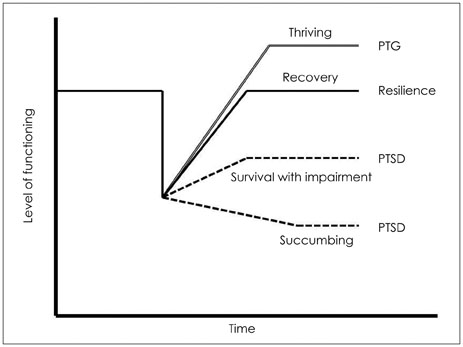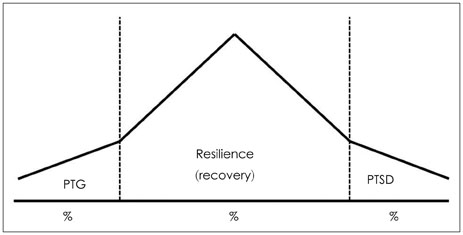J Korean Neuropsychiatr Assoc.
2015 Feb;54(1):32-39. 10.4306/jknpa.2015.54.1.32.
Posttraumatic Growth and Resilience: Assessment and Clinical Implications
- Affiliations
-
- 1Department of Psychiatry, College of Medicine, Korea University, Ansan Hospital, Ansan, Korea. hancs@korea.ac.kr
- 2National Ansan Trauma Center, Ansan, Korea.
- 3Department of Psychiatry, College of Medicine, Hanyang University, Seoul, Korea.
- 4Department of Psychiatry, College of Medicine, The Catholic University of Korea, Seoul, Korea.
- 5Ansan City Mental Health Center, Ansan, Korea.
- KMID: 2343996
- DOI: http://doi.org/10.4306/jknpa.2015.54.1.32
Abstract
- Stress and trauma research has traditionally focused on the negative sequela of adversity. Recently, research has begun to focus on positive outcomes, specifically posttraumatic growth (PTG)-"positive change experienced as a result of the struggle with trauma"-which emphasizes the transformative potential of one's experiences with highly stressful events and circumstances. For evaluation of PTG, resilience is very important. Resilience refers to a person's ability to successfully adapt to acute stress, trauma or more chronic forms of adversity, maintaining psychological well-being. This article introduces several measurement scales for assessment of PTG and resilience. In addition, we suggest psychological techniques for facilitating PTG focusing on the relationship with adaptation after trauma. Finally, we discuss the applicability of a therapeutic approach for PTG in clinical practice. The systemic review of this article will provide further directions for PTG and resilience.
Keyword
Figure
Cited by 1 articles
-
A Meta-Analysis of Intervention Research for Posttraumatic Growth in Cancer Patients
Mi Hyang Park, Jeong Sook Park
Asian Oncol Nurs. 2016;16(1):9-19. doi: 10.5388/aon.2016.16.1.9.
Reference
-
1. Brewin CR, Holmes EA. Psychological theories of posttraumatic stress disorder. Clin Psychol Rev. 2003; 23:339–376.
Article2. Tedeschi RG, Calhoun LG. The Posttraumatic Growth Inventory: measuring the positive legacy of trauma. J Trauma Stress. 1996; 9:455–471.
Article3. Tedeschi RG, Calhoun LG. Trauma and Transformation: Growing in the Aftermath of Suffering. London: Sage Publications;1995. p. 77–88.4. Mastena AS, Besta KM, Garmezya N. Resilience and development: contributions from the study of children who overcome adversity. Dev Psychopathol. 1990; 2:425–444.
Article5. McMillen JC, Fisher RH. The perceived benefit scales: measuring perceived positive life changes after negative events. Soc Work Res. 1998; 22:173–187.
Article6. Park CL, Cohen LH, Murch RL. Assessment and prediction of stressrelated growth. J Pers. 1996; 64:71–105.
Article7. Davis CG, Nolen-Hoeksema S, Larson J. Making sense of loss and benefiting from the experience: two construals of meaning. J Pers Soc Psychol. 1998; 75:561–574.
Article8. Roesch SC, Rowley AA, Vaughn AA. On the dimensionality of the stress-related growth scale: one, three, or seven factors? J Pers Assess. 2004; 82:281–290.
Article9. Abraído-Lanza AF, Guier C, Colón RM. Psychological thriving among latinas with chronic illness. J Soc Issues. 1998; 54:405–424.
Article10. Frazier P, Conlon A, Glaser T. Positive and negative life changes following sexual assault. J Consult Clin Psychol. 2001; 69:1048–1055.
Article11. Antoni MH. Stress management intervention for women with breast cancer. Washington, DC: American Psychological Association Press;2003. p. 31–38.12. Kilmer RP, Gil-Rivas V, Tedeschi RG, Cann A, Calhoun LG, Buchanan T, et al. Use of the revised posttraumatic growth inventory for children. J Trauma Stress. 2009; 22:248–253.
Article13. Meyerson DA, Grant KE, Carter JS, Kilmer RP. Posttraumatic growth among children and adolescents: a systematic review. Clin Psychol Rev. 2011; 31:949–964.
Article14. Tedeschi RG, Park CL, Calhoun LG. Posttraumatic growth: positive changes in the aftermath of crisi. New Jersey: Routledge;1998. p. 1–22.15. Leigh H. Posttraumatic Growth: Positive Changes in the Aftermath of Crisis. Am J Psychiatry. 2000; 157:1712.
Article16. Windle G, Bennett KM, Noyes J. A methodological review of resilience measurement scales. Health Qual Life Outcomes. 2011; 9:8.
Article17. Connor KM, Davidson JR. Development of a new resilience scale: the Connor-Davidson Resilience Scale (CD-RISC). Depress Anxiety. 2003; 18:76–82.
Article18. Jung YE, Min JA, Shin AY, Han SY, Lee KU, Kim TS, et al. The Korean version of the Connor-Davidson Resilience Scale: an extended validation. Stress Health. 2012; 28:319–326.
Article19. Smith BW, Dalen J, Wiggins K, Tooley E, Christopher P, Bernard J. The brief resilience scale: assessing the ability to bounce back. Int J Behav Med. 2008; 15:194–200.
Article20. Friborg O, Hjemdal O, Rosenvinge JH, Martinussen M. A new rating scale for adult resilience: what are the central protective resources behind healthy adjustment? Int J Methods Psychiatr Res. 2003; 12:65–76.
Article21. Wagnild G. A review of the Resilience Scale. J Nurs Meas. 2009; 17:105–113.
Article22. Park CL, Mills-Baxter MA, Fenster JR. Post-traumatic growth from life's most traumatic event: influences on elders' current coping and adjustment. Traumatol. 2005; 11:297–306.
Article23. Maercker A, Zoellner T. The janus face of self-perceived growth: toward a two-component model of posttraumatic growth. Psychol Inq. 2004; 15:41–48.24. Zoellner T, Maercker A. Posttraumatic growth in clinical psychology - a critical review and introduction of a two component model. Clin Psychol Rev. 2006; 26:626–653.
Article25. Schorr YH, Roemer L. Posttraumatic meaning making: toward a clearer definition. In : Poster presented at the annual meeting of the International Society for Traumatic Stress Studies in Baltimore, MD; 2002.26. Helgeson VS, Reynolds KA, Tomich PL. A meta-analytic review of benefit finding and growth. J Consult Clin Psychol. 2006; 74:797–816.
Article27. Ickovics JR, Meade CS, Kershaw TS, Milan S, Lewis JB, Ethier KA. Urban teens: trauma, posttraumatic growth, and emotional distress among female adolescents. J Consult Clin Psychol. 2006; 74:841–850.
Article28. Rini C, Manne S, DuHamel KN, Austin J, Ostroff J, Boulad F, et al. Mothers' perceptions of benefit following pediatric stem cell transplantation: a longitudinal investigation of the roles of optimism, medical risk, and sociodemographic resources. Ann Behav Med. 2004; 28:132–141.
Article29. Armeli S, Gunthert KC, Cohen LH. Stressor appraisals, coping, and post-event outcomes: the dimensionality and antecedents of stress-related growth. J Soc Clin Psychol. 2001; 20:366–395.
Article30. Goodwin PJ, Leszcz M, Ennis M, Koopmans J, Vincent L, Guther H, et al. The effect of group psychosocial support on survival in metastatic breast cancer. N Engl J Med. 2001; 345:1719–1726.
Article31. Devilly GJ. Eye movement desensitization and reprocessing: a chronology of its development and scientific standing. Sci Rev Ment Health Pract. 2002; 1:113–138.32. Wilson SA, Becker LA, Tinker RH. Eye movement desensitization and reprocessing (EMDR) treatment for psychologically traumatized individuals. J Consult Clin Psychol. 1995; 63:928–937.
Article
- Full Text Links
- Actions
-
Cited
- CITED
-
- Close
- Share
- Similar articles
-
- A Structural Equation Model of Factors Influencing Posttraumatic Growth of Earthquake Victims
- Depression as a Mediator of the Relationship Between Resilience and Posttraumatic Stress Symptoms and Dissociation in Firefighters
- Predictors of the Posttraumatic Growth in Parents of Children with Leukemia
- The Benefits of Indirect Exposure to Trauma: The Relationships among Vicarious Posttraumatic Growth, Social Support, and Resilience in Ambulance Personnel in China
- The Effect of Positive Psychological Characteristics on Post-Traumatic Stress Symptoms after Traumatic Experiences in Firefighters



